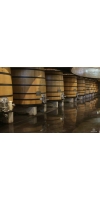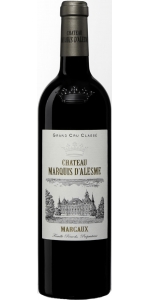Wine from Marquis d'Alesme

Grand Cru Classé in 1855, Chateau Marquis d’Alesme contributes in its way to building the history and reputation of Margaux. Its successive owners, well-known for their cosmopolitan culture, helped to develop the estate over the centuries, guided by a love of beauty and the desire to produce a great wine.
Today Nathalie Perrodo continues, with great enthusiasm, to pursue her father’s goals, while bringing a new dynamic to the estate. Alongside Marjolaine Maurice de Coninck, the General Director, she is writing a new chapter in the history of the estate, where the meticulous care that is taken to make a Great Wine is superbly reflected in the tasting experience.
In one of the world’s most prestigious wine-growing areas, the terroir of Marquis d’Alesme offers all the right conditions for achieving the level of excellence necessary for great wines. The soil (gravelly-siliceous, marly-siliceous and clay & limestone), is ideally exposed on natural gentle slopes. The weather is mild thanks to the presence of the nearby Gironde estuary. This unique environment produces a great wine with an exceptionally rich range of flavors.
The Cabernet “family” reigns supreme here, representing 70% of the grape varieties used (63% Cabernet Sauvignon, 5% Petit Verdot, 2% Cabernet Franc). They bring concentration and structure, and comprise the backbone of the wine, while Merlot (30% of the grape varieties) gives a delicate roundness. Elegant and refined, often with a bouquet featuring floral and black fruit notes, the wines of Marquis d’Alesme are richly flavourful, with juicy blackcurrant, blackberry, and blueberry notes alongside well-balanced minerality.
Marquis d'Alesme Margaux is made from 63% Cabernet Sauvignon, 30% Merlot, 5% Petit Verdot and 2% Cabernet Franc.
- back
Selected Options
Wineries
Categories
Pricing
Countries
Regions
Grape Types
Wineries
Organic/Free Shipping
The aging is as Mounir ages his Burgundies: extremely long, never racked, no fining, no filtration. It would be easy to say that we expected the experience running one of Burgundy’s leading producers, Lucien Le Moine, would show in Mounir’s wines. But the actual results need to be tasted to be believed and understood: a wine with beguiling fruit and savory richness, yet extraordinary finesse and detail.
Mounir Saouma likes to describe Châteauneuf-du-Pape as a mosaic, with all the wild traditions and differences together making for very different interpretations. Omnia, Latin for “all,” is his attempt to encompass the entire region’s terroir and winemaking history (and perhaps future) in one glass. The fruit comes from 9 vineyard parcels across all 5 of the Châteauneuf communes, Châteauneuf-du-Pape, Courthezon, Sorgues, Bedarrides and Orange (in early vintages, when the Saoumas did not have all the vineyards they have today, they would purchase fruit; today, Rotem & Mounir Saouma is 100% Estate). The wine is then vinified and aged in foudres, cement and 500 liter barrels – a little bit of everything.
2019 was another warm and dry vintage in the southern Rhône, marked by insistent drought and repeated heat waves during the season. With little disease pressure or frost, the crop was close to normal size, but bunch and berry-size was reduced during the growing season by the lack of water. The grapes were thus concentrated and rich in sugar and acidity, although potential alcohol levels were often quite high. Vineyards at higher elevations – Châteauneuf du Pape and Gigondas in particular — handled the heat better, and the wines from those AOPs are rich yet also remarkably fresh and energetic. Despite the initial concerns about the growing season, 2019 looks to be a watershed vintage in the Southern Rhône, producing rich wines with exceptional concentration and aging potential
Inviting aromas of sliced strawberries, red cherries and rose. Full-bodied with vibrant acidity and succulent fruit. Fine, structured tannins are vertically aligned with the fruit. More dark-fruited than the nose lets on and entirely delicious. I love the subtle spice here.
-James Suckling 94 Points
Very refined, with silky and fine-grained structure carrying alluring bergamot, rooibos tea, incense, dried cherry and lightly mulled raspberry notes along. A long sanguine thread weaves through the finish. Hard to resist now with so much charm, but this will benefit from cellaring. Grenache, Syrah and Mourvèdre.
-Wine Spectator 94 Points
Argot Indigo Syrah is made from 100 percent Syrah.
The color of exaltation, opulence and elusiveness. The Indigo pigment has held sway over the heads and hearts of humans for centuries. Each vintage we honor this legacy by creating a Syrah which captures the might, richness and intrigue of the ‘Indigo’ legend. Profound, captivating and endlessly intriguing. Delicious.
Review:
The single-varietal 2021 Indigo Syrah is deep garnet-purple in color. Notes of plum preserves, fruitcake, and licorice jump from the glass, with nuances of rose oil, cardamom, and cumin seed. The full-bodied palate is concentrated and plush, with bright acidity to balance and a long spicy finish.
-Wine Palate 96 Points





